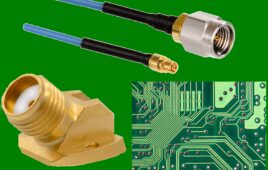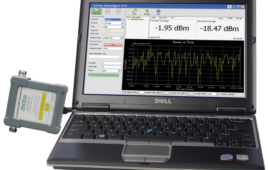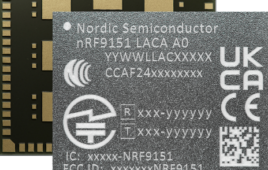Frequency-control components, such as crystal oscillators, are essential to the success of current and next generation wireless systems, notably in wireless infrastructure equipment, which continues to evolve. As circuit and system designers develop wireless infrastructure equipment for physically smaller and lower-power installations, such as wireless small cells for use within public venues, crystal oscillators provide the means of maintaining the frequency and timing needed among different parts of the wireless infrastructure. Crystal oscillators, including voltage-controlled crystal oscillators (VCXOs), temperature-compensated crystal oscillators (TCXOs), and oven-controlled crystal oscillators (OCXOs) continue to meet the demands of the next generation wireless infrastructure with improving performance in smaller packages. Knowing how these oscillators differ and how their performance characteristics relate to the requirements of wireless infrastructure equipment can greatly simplify the task of specifying an oscillator for wireless infrastructure equipment.
Wireless infrastructure continues to grow with the number of wireless users and their requirements for clear voice, faster data, and seamless higher capacity service from their mobile devices. Next generation wireless systems based on the Long Term Evolution-Advanced (LTE-A) cellular communications technologies continue to expand with the addition of small cell sites to increase the capacity of wireless networks by adding connections within urban areas and buildings. The increase of modulation order to 256 QAM in LTE-A Release 12 imposes tougher error-vector-modulation (EVM) specifications, which imply tighter phase noise requirements on these components.
The effective operation of these smaller cells within wireless networks depends on efficient reuse of frequencies within the network and minimal interference between cells. Reliable frequency control within a wireless network falls to frequency control components, such as crystal oscillators, designed into the wireless infrastructure equipment, such as receivers and transmitters. Crystal oscillators are designed to provide a stable reference frequency that remains accurate over time notwithstanding changes in temperature, operating voltages, and other factors that can induce changes in the frequency of wireless networks. Just as importantly, even when the frequency over time is extremely accurate, short term variations cycle to cycle generate phase noise, which can result in poor EVM and bit errors as the modulation order increases.
Crystal oscillators for use in wireless infrastructure equipment, such as picocells and femtocells, come in various forms and levels of performance, depending upon circuit and system requirements. Most oscillators are available in miniature surface-mount-technology (SMT) housings. These tiny packages support the high-density layouts used in printed circuit boards (PCBs) designed to shrink small cell wireless infrastructure equipment.
Within a system, the master oscillator provides the primary heartbeat to the system and needs to be very accurate even though it will normally be locked to the core of network. This clock is commonly scaled up to both the higher clock rates needed by baseband digital signal processors (DSPs) and data converters (ADCs and DACs). Finally, a frequency synthesizer will be employed to convert clock rates to the final RF/microwave frequencies required by the wireless system.
Basically, VCXOs can be thought of as a frequency control building block. When used in a phase-locked loop (PLL), VCXOs can convert the frequency of the master oscillator to a different frequency but still be locked to the accuracy of that source, helping to attenuate some of the jitter in that source. TCXOs can be thought of as more stable VCXOs that add a temperature sensor to detect changes in temperature and apply a voltage to the internal VCXO to correct for any frequency shifts resulting from the temperature changes. OCXOs go even further by building a thermally insulated environment around the TCXO, adding a heater and heater control circuit (i.e. an oven) to maintain a narrow temperature range on the inside of the ovenized packaging for extremely tight control of frequency across wide temperature ranges. Also, OCXOs often use crystals designed to have a flatter frequency-versus-temperature response around the target temperature of the oven.
Oscillators are available with different output types depending upon the needs of an application, such as clipped-sine-wave, CMOS, LVDS, and LV-PECL outputs. Crystal oscillators are also constructed with different quartz crystal resonator structures, including AT-cut and stress-compensated (SC)-cut crystal resonators. The different crystal cuts refer to how a crystal blank is cut in relation to its three axes, and the type of cut impacts performance. For example, oscillators with AT-cut crystals are usually lower in cost but less accurate in frequency and not as low in phase noise as oscillators using SC-cut crystal resonators, which are cut for low sensitivity to thermal and mechanical stresses and well suited for use in ovenized crystal oscillators.
Making a Match
Specifying an oscillator is a matter of finding a component with performance levels and characteristics that meet the requirements of a wireless infrastructure application, which differs for a femtocell, picocell, or macrocell. The key specifications to consider when comparing different crystal oscillators for any application include frequency, output type, frequency stability, phase noise, operating temperature range, supply voltage, power consumption, and package. As with many high frequency components, higher levels of performance usually come at a higher price.
Crystal oscillators, whether VCXOs, TCXOs or OCXOs, can be designed and constructed to meet a wide range of performance and size requirements for wireless infrastructure equipment. While the clock frequency may be the starting point when specifying a crystal oscillator, that frequency is meaningless without good frequency stability. An oscillator’s stability is a measure of how well it will maintain its frequency over a number of variable conditions, such as temperature, vibration, supply voltage, load, and time.
Some examples may show how different oscillator solutions can serve different parts of modern wireless infrastructure.
Many baseband processor or transceiver chipsets need a low phase noise clock commonly at 122.88, 153.60 or 245.76 MHz which are higher than the master oscillator’s usual 10.0 to 40.0 MHz frequency. At lower cost and smaller size than designing one’s own VCXO with a custom pullable crystal, one company has a new family of High Frequency Fundamental (HFF) VCXOs supporting frequencies from 100 to 250 MHz in 3.2 x 5.0 mm and 5.0 x 7.0 mm sizes with a choice of CMOS, LV-PECL, and LVDS outputs. For example, the model 315 with CMOS output offers ±25 ppm stability over temperatures from -40 to +85°C, with ±50 ppm absolute pull range and -155 dBc/Hz phase noise at 100 kHz offset from a 122.88 MHz carrier frequency.
Macro basestations are one of the most demanding wireless infrastructure equipment applications that must serve large geographic areas and large numbers of users, requiring the highest performance. Wide area power class macrocell basestations require a minimum of ±50 ppb stability, although many customers seek much less than half that. A new, improved version of the 36 x 27 mm model 196 double-oven OCXO meets the most demanding macro basestation specifications, delivering <±6 ppb for 14-day holdover covering -40 to +85°C temperature range, as well as full supply voltage and load variation, exhibiting -155 dBc/Hz phase noise at 100 kHz offset and <0.01 ppb short term Allan deviation over a 1 s duration.
Medium-range and local-area power class picocell basestations require ±100 ppb stability and extremely low phase noise to support 256QAM in LTE Release 12. A low cost solution to meet these needs is the 13 x 20 mm model 138. The smallest solution is the 9 x 14 mm model 149, and the lowest power consumption solution at 0.15 W steady-state power consumption is the model 144 (see Table 1 for detailed comparisons). These oscillators all meet customer requirements, including 14-day holdover from -40 to +85°C, as well as full supply voltage and load variation requirements.
Wireless systems, such as remote radio heads, which are either always enslaved to the network or to a base station or are lower in the timing hierarchy, generally use voltage controlled TCXOs (VCTCXOs) as their master oscillator. The same is true for home area power class femtocells, which require ±250 ppb stability but may or may not need holdover. Moreover, femtocells usually only need oscillators capable of supporting narrower indoor temperature ranges. When holdover is not critical, the 2.0 x 2.5 mm model 520 VCTCXO typically delivers -150 dBc/Hz phase noise (as much as 6 dB better performance than similar products) needed for LTE-A. When better performance or holdover is required, the 3.2 x 5.0-mm model 580 typically delivers -155 dBc/Hz phase noise and can be specified to meet the ±250 ppb holdover requirement.
Of course, these oscillators represent a small sampling of the frequency control products available for wireless infrastructure. While even a basic oscillator can lock to network timing, the critical differences in holdover stability, wander, jitter, and phase noise requirements dictate the need for precision frequency control.




